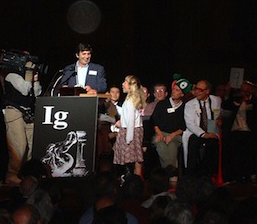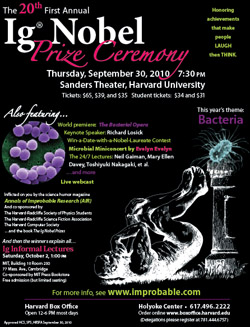Ig Nobelist Goes on to Win the Real Thing—No, This is Not a Headline from The Onion
-
-
slice.mit.edu
- 3
Filed Under
Recommended

It's that time of year, when Nobel prizes are doled out a day at a time and the Ig Nobel awards put the funny in high-brow prizes by honoring achievements that make people laugh, then think. Like confirming the widely held belief that swearing relieves pain. And scientifically documenting fellatio in fruit bats. And using slime mold to determine the optimal routes for railroad tracks.
Yesterday came news that Ig Nobelist Andre Geim, who received his accolade in 2000 with Sir Michael Berry for using magnets to levitate a frog (see video below and listen to the NPR broadcast), became the first individual to then garner an actual Nobel, which he won in physics with Konstantin Novoselov for their work with the atom-thick carbon graphene. [Though Ig Nobelist Bart Knols, who won for showing that the female malaria mosquito Anopheles gambiae is attracted equally to the smell of Limburger cheese and human feet, also won a Nobel Prize but as one of hundreds of employees of the International Atomic Energy Agency awarded a Nobel Peace Prize in 2005.]

The Ig Nobel prize ceremony is unlike any other. It is attended by the King and Queen of Swedish Meatballs. Actual Nobel Laureates—this year's group included MIT Professor of Physics Frank Wilczek—hand out the prizes. There's the world premiere of a mini-opera performed by professional singers—check out the complete librettos from years' past. All speeches are kept "delightfully brief." And random characters may appear on stage, like the V-Chip Monitor, who guards against offensive words, sounds, thoughts, or imaginings.
This year's theme was bacteria, and for their accomplishments, winners received a plaque with a bacteria-covered Petri dish, a bacteria-covered slip of paper, and 10 trillion (Zimbabwe) dollars. One such winner was Eric Adams SM '72, PhD '75, a senior lecturer, senior research engineer, and director of MIT's MEng program, who co-won the chemistry prize for disproving the old belief that oil and water don't mix.
Two days after the awards ceremony, held at Harvard University, the winners presented informal lectures at MIT during which they were given five minutes to explain what they did and why. Past winners also returned to give two-minute updates on their work.
The Ig Nobel prizes are administered by the Cambridge-based organization Improbable Research, which also publishes a newsletter, magazine, blog, newspaper column, and books, and produces live events and a TV series all about, you guessed it, improbable research. Highlights of the ceremony will be broadcast Nov. 26, the day after Thanksgiving, on National Public Radio and online. Check out video of past events.
Curious how the Ig Nobels started? Read about the debut of the awards in 1991 as reported on by the Tech.
Here's that levitating frog, in case you're interested:








Comments
Otto
Tue, 08/20/2013 7:48pm
Hello PETER,
in 2011 we also quoted your 1980 work in dealing with SW propagation in honeycomb lattices (graphene, nanoribbon, fullerenes, nannotori silicene etc etc)
you may go to http://www.mdpi.com/1422-0067/12/11/7934
ciao OTTO
Cleo
Sun, 11/21/2010 3:28pm
Hey there, this is a really good post. Definitely enjoyed reading that. Later
Michael Pyshnov
Wed, 10/06/2010 3:38pm
In 1980, I published an article describing a model of one biological structure - the crypt of intestinal epithelium, completely similar to the structure later found in graphene tubes (Pyshnov, M. B., Topological Solution for Cell Proliferation in Intestinal Crypt, J. theor. Biol., 1980, v.87, 189-200). In 2005, Sergei Fedorov and myself published a computer simulation of topological transformations occuring in the model of the crypt (http://www.cell-division-program.com/index.php). Apparently, these works remain largely unknown to physicists, with the exception of one reference to them (www.mpipks-dresden.mpg.de/~coqusy06/SLIDES/vozmediano.pdf), where the structure of the crypt is called "a living curiosity". Only from this reference I learned about graphene.
Publications describing graphene tubes are appearing, repeating the discovery of topological properties found in the model of the crypt. Some of them are adding a topological closure to the graphene tube at one end. Such closure is completely similar to the bottom part of the crypt model. I am not sure, however, that the interdependency between the structure of this closure and the structure of the cylindrical part of the graphene tube is understood in the degree it was shown in my 1980 paper and subsequently in the computer model of 2005.
The crypt model also includes the complex process of replacing dying cells with the new cells appearing by cell division, while graphene is a structure not capable of anything like multiplication of the elements of its structure, the atoms. However, when the formation of defects in the structure of graphene occurs, the explanation of structural transformations found in the crypt model can probably be helpful. To conclude, I find the striking similarities very delightful, and I hope that one day biological structures will receive at least as much attention of the researchers.